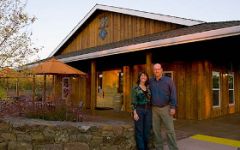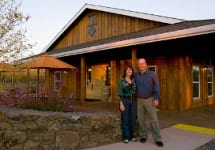Jeff Runquist R Dick Cooper Vineyard Barbera 2019
-
Connoisseurs'
Guide



Product Details
Your Rating
Somm Note
Winemaker Notes
Professional Ratings
-
Connoisseurs' Guide
Some four decades back, Dick Cooper made the fateful decision to cultivate Barbera in Amador County with a mind to making serious, high-quality wines and in the subsequent years earned the apt sobriquet “the Godfather of Barbera.” Long regarded as one of the best growers, if not the best, of Barbera anywhere in the state, Mr. Cooper sadly passed away last July at the age of 81, but his legacy is sure to endure for generations to come. This top-tier effort sourced from the Cooper Ranch and made by Jeff Runquist is nothing less than a varietal tour de force and is as deep, well-structured and complex as any Barbera around. It is a big wine, and it is not shy about showing its ripeness, but few impress as being as layered as it is, and, however involving it admittedly is now, we are more than optimistic about how it will evolve over the next five to ten years. We have a strong hunch that Barbera’s godfather would approve.


Jeff produces wines from grapes grown throughout California. At last count he was planning to crush over twenty different varieties from nine different appellations for the 2013 vintage. Most of these wines are produced in very small limited quantities. However, there are four principle wines that the winery strives to have available throughout the year and they are: Petite Sirah, Zinfandel, Barbera, and Petit Verdot. ll of Jeff's wines share a theme of fresh fruit reflective of the varietal flavors inherent in the grapes. Jeff selects grapes from vineyards that provide rich full flavors without loads of astringent tannins.

Friendly and approachable, Barbera produces wines in a wide range of styles, from youthful, fresh and fruity to serious, structured and age-worthy. Piedmont is the most famous source of Barbera; those from Asti and Alba garner the most praise. Barbera actually can adapt to many climates and enjoys success in some New World regions. Somm Secret—In the past it wasn’t common or even accepted to age Barbera in oak but today both styles—oaked and unoaked—abound and in fact most Piedmontese producers today produce both styles.

As the lower part of the greater Sierra Foothills appellation, Amador is roughly a plateau whose vineyards grow at 1,200 to 2,000 feet in elevation. It is 100 miles east of both San Francisco and Napa Valley. Most of its wineries are in the oak-studded rolling hillsides of Shenandoah Valley or east in Fiddletown, where elevations are slightly higher.
The Sierra Foothills growing area was among the largest wine producers in the state during the gold rush of the late 1800s. The local wine industry enjoyed great success until just after the turn of the century when fortune-seekers moved elsewhere and its population diminished. With Prohibition, winemaking was totally abandoned, along with its vineyards. But some of these, especially Zinfandel, still remain and are the treasure chest of the Sierra Foothills as we know them.
Most Amador vines are planted in volcanic soils derived primarily from sandy clay loam and decomposed granite. Summer days are hot but nighttime temperatures typically drop 30 degrees and the humidity is low, making this an ideal environment for grape growing. Because there is adequate rain throughout the year and even snow in the winter, dry farming is possible.
